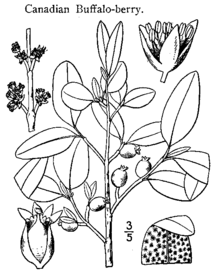Shepherdia canadensis
| Shepherdia canadensis | |
|---|---|
| | |
| Scientific classification | |
| Kingdom: | Plantae |
| (unranked): | Angiosperms |
| (unranked): | Eudicots |
| (unranked): | Rosids |
| Order: | Rosales |
| Family: | Elaeagnaceae |
| Genus: | Shepherdia |
| Species: | S. canadensis |
| Binomial name | |
| Shepherdia canadensis (L.) Nutt. | |
| Synonyms[1] | |
| |
The Canada buffaloberry (Shepherdia canadensis), also known as russet buffaloberry,[2] soopolallie, soapberry, or foamberry (Ktunaxa: kupaʔtiǂ[3]), is one of a small number of shrubs of the genus Shepherdia bearing edible red berries. It is widespread across most of Canada (every province except Prince Edward Island plus all 3 territories) and the western and northern United States (including Alaska).[4]
One recognized form however bears yellow fruits. The berries have an extremely bitter taste.
The plant is a deciduous shrub found in open forests and thickets. The shrub reaches a height of 1–4 m (3.3–13.1 ft).
Fruits are extensively collected by some Canadian First Nations peoples such as Nlaka'pamux (Thompson), St'at'imc (Lillooet) and Secwepemc (Shuswap) in the province of British Columbia. The bitter berries are not eaten directly but rather processed as sxusem ("sxushem", also xoosum/"hooshum") or "Indian ice cream". Branches bearing fruit are hit with a stick and only the very ripe fruits that fall off are collected. A clean mat or tarpaulin is placed below the bush for collection. The berries are then put in a large clean bowl and mixed with sweet fruit such as raspberries. The mixture of berries is crushed, then vigorously beaten in the manner of whipping cream in order to raise the characteristic foam of the dish. The berry is both sweet and bitter, possibly comparable to sweetened coffee. The substance is believed by the First Nations peoples who prepare it to have many healthful properties, but the saponin chemicals which create the foam may also cause gastrointestinal irritation if consumed in large quantities. Native theme restaurants in British Columbia have occasionally had sxusem on the menu in recent years.[5]

Unrelated plants in the genus Sapindus produce highly toxic saponins and share the common name soapberry with the edible Canada buffaloberry.
The common name of the plant in British Columbia is soopolallie, a word deriving from the historic Chinook Jargon trading language used in the North American Pacific Northwest in the 19th and early 20th centuries. The name is a composite of the Chinook words for soap (soop) and berry (olallie).[5]
References
- ↑ The Plant List, Shepherdia canadensis (L.) Nutt.
- ↑ "Shepherdia canadensis". Natural Resources Conservation Service PLANTS Database. USDA. Retrieved 11 November 2015.
- ↑ "FirstVoices: Nature / Environment - place names: words. Ktunaxa.". Retrieved 2012-07-07.
- ↑ Biota of North America Program 2014 state-level distribution map
- 1 2 Turner, Nancy J, Laurence C. Thompson, M. Terry Thompson and Annie Z. York. 1990. Thompson Ethnobotany. Royal British Columbia Museum: Victoria. Pp. 209–211.
External links
- United States Department of Agriculture Plants profile for Shepherdia canadensis (russet buffaloberry)
- Province of British Columbia Ministry of Forests: Shepherdia canadensis (soopolallie)
| Wikimedia Commons has media related to Shepherdia canadensis. |